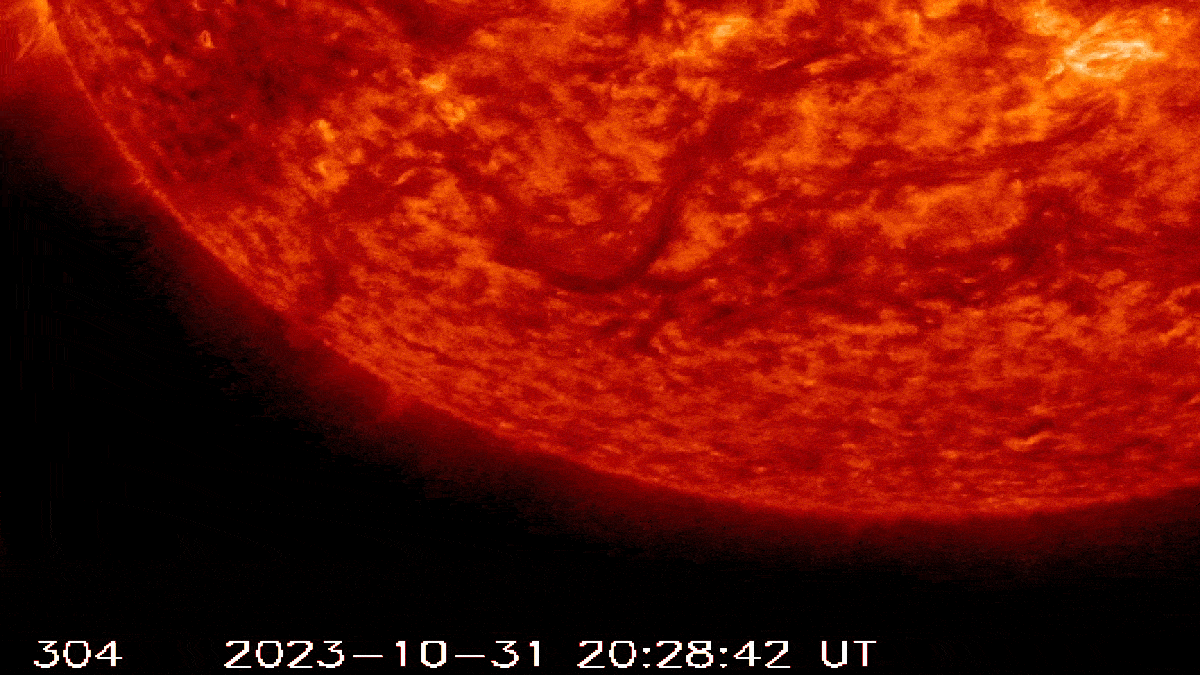Massive solar eruption carves 60,000-mile-long 'canyon of fire' into the sun on Halloween night
A powerful explosion from the sun briefly opened up an enormous valley on the solar surface that was more than twice as wide as the contiguous U.S. and seven times longer than Earth.
A massive plume of plasma that erupted from the sun on Halloween briefly carved out an enormous "canyon of fire" on the solar surface that was twice as wide as the contiguous U.S. and more than seven times as long as Earth.
The enormous, fiery valley is another striking reminder that the sun is fast approaching its explosive peak — the solar maximum.
In the late hours of Oct. 31, a loop of magnetized plasma, known as a solar prominence, grew in the sun's southern hemisphere and became unstable, before breaking off and launching into space like a snapped elastic band, Spaceweather.com reported.
As the prominence raced away, it left behind a gigantic, canyon-like hole in the superhot plasma that makes up the sun's surface. This "canyon of fire" was around 6,200 miles (10,000 kilometers) wide and stretched 10 times as long, according to Live Science's sister site Space.com.
Related: 15 dazzling images of the sun
The plasma ravine was around 620 times wider and 224 times longer than the Grand Canyon and around 50 times wider and 25 times longer than the Valles Marineris on Mars —the largest-known canyon in the solar system.
This is not the first "canyon of fire" that has been spotted on the sun in recent years: In April 2022, a 124,000-mile-long (200,000 km) canyon opened up on the sun; and in September the same year, an even larger canyon stretching a whopping 239,000 miles (385,000 km) appeared after an epic solar eruption. Both of these canyons were around 12,400 miles (20,000 km) deep, which is around 1,800 times deeper than the Mariana Trench.
Get the world’s most fascinating discoveries delivered straight to your inbox.
The plasma plumes that get flung from the sun to birth these canyons can eventually barrel into Earth and trigger geomagnetic storms and vibrant auroras. Initially, scientists were concerned that the catapulted prominence from the latest eruption could hit our planet. But follow-up observations revealed it will now miss us completely, Spaceweather.com reported.
Related: 10 solar storms that blew us away in 2022
The massive solar canyon is the latest sign that we are rapidly approaching solar maximum — the explosive peak in the sun's roughly 11-year solar cycle, which is now likely to arrive in 2024, a year earlier than initially forecast.
In the lead-up to solar maximum, the sun's magnetic field lines begin to get tangled up. These invisible lines are normally what constrain plasma to the sun's surface. But when they get intertwined, they become less effective at holding plasma in place, which enables large prominences and deep valleys to form on the surface.
The weaker surface magnetism has also led to a range of other intriguing plasma structures this year including an enormous polar vortex that swirled around the sun's north pole, a towering solar tornado taller than 14 Earths and a logic-defying plasma waterfall that showered the sun with fiery rain.

Harry is a U.K.-based senior staff writer at Live Science. He studied marine biology at the University of Exeter before training to become a journalist. He covers a wide range of topics including space exploration, planetary science, space weather, climate change, animal behavior and paleontology. His recent work on the solar maximum won "best space submission" at the 2024 Aerospace Media Awards and was shortlisted in the "top scoop" category at the NCTJ Awards for Excellence in 2023. He also writes Live Science's weekly Earth from space series.





